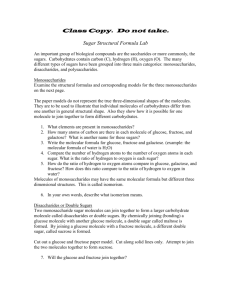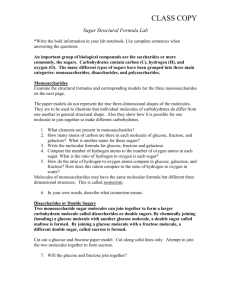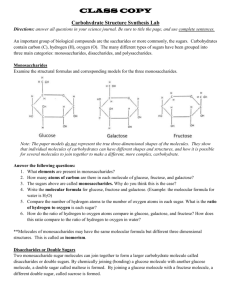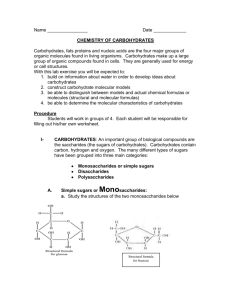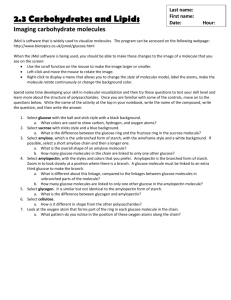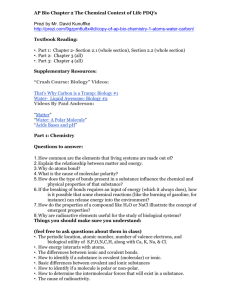Sugar Structural Formula Lab
advertisement
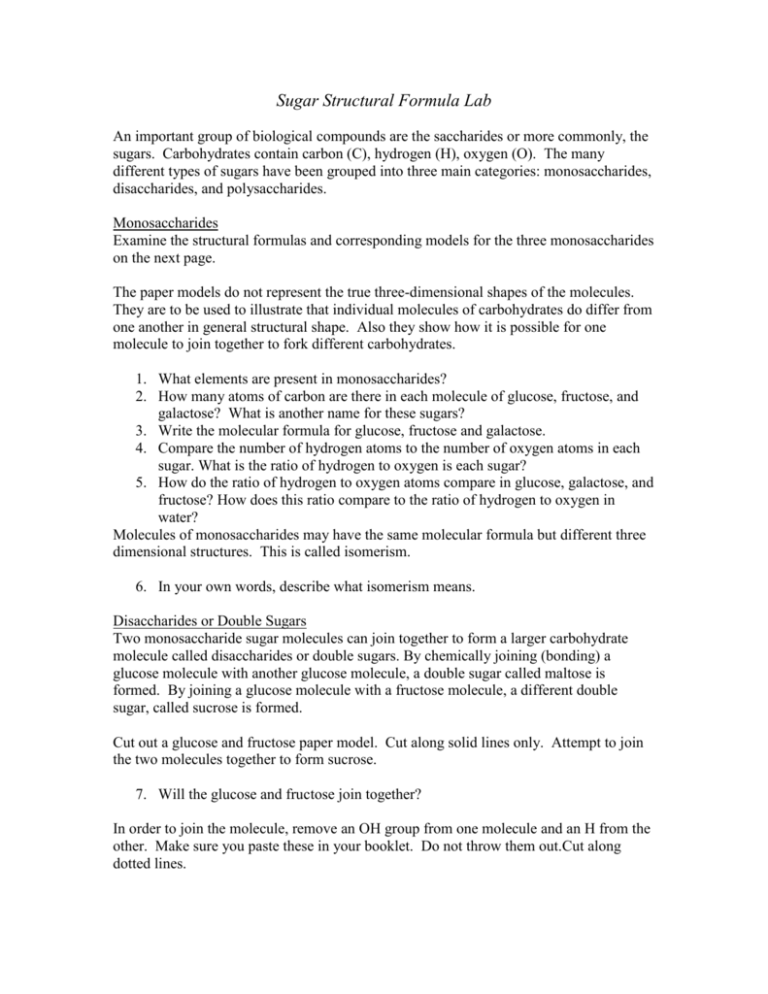
Sugar Structural Formula Lab An important group of biological compounds are the saccharides or more commonly, the sugars. Carbohydrates contain carbon (C), hydrogen (H), oxygen (O). The many different types of sugars have been grouped into three main categories: monosaccharides, disaccharides, and polysaccharides. Monosaccharides Examine the structural formulas and corresponding models for the three monosaccharides on the next page. The paper models do not represent the true three-dimensional shapes of the molecules. They are to be used to illustrate that individual molecules of carbohydrates do differ from one another in general structural shape. Also they show how it is possible for one molecule to join together to fork different carbohydrates. 1. What elements are present in monosaccharides? 2. How many atoms of carbon are there in each molecule of glucose, fructose, and galactose? What is another name for these sugars? 3. Write the molecular formula for glucose, fructose and galactose. 4. Compare the number of hydrogen atoms to the number of oxygen atoms in each sugar. What is the ratio of hydrogen to oxygen is each sugar? 5. How do the ratio of hydrogen to oxygen atoms compare in glucose, galactose, and fructose? How does this ratio compare to the ratio of hydrogen to oxygen in water? Molecules of monosaccharides may have the same molecular formula but different three dimensional structures. This is called isomerism. 6. In your own words, describe what isomerism means. Disaccharides or Double Sugars Two monosaccharide sugar molecules can join together to form a larger carbohydrate molecule called disaccharides or double sugars. By chemically joining (bonding) a glucose molecule with another glucose molecule, a double sugar called maltose is formed. By joining a glucose molecule with a fructose molecule, a different double sugar, called sucrose is formed. Cut out a glucose and fructose paper model. Cut along solid lines only. Attempt to join the two molecules together to form sucrose. 7. Will the glucose and fructose join together? In order to join the molecule, remove an OH group from one molecule and an H from the other. Make sure you paste these in your booklet. Do not throw them out.Cut along dotted lines. 8. Does this aid in joining the molecules? 9. The H and OH, removed from the simpler sugars join to form what? Construct a maltose molecule by joining together two glucose molecules. Do not throw away the H and OH. Please paste them into your booklet. 10. What is the name of this reaction? 11. Write the molecular formula for maltose by adding the correct subscripts (remember the H20 was lost) 12. Write the molecular formula for sucrose. 13. Determine the ratios of hydrogen atoms to oxygen atoms for both sucrose and maltose. 14. How does this ration compare to the ratio of hydrogen to oxygen in water? 15. Does isomerism exist in double sugars? (Compare your model of sucrose to your model of maltose). 16. How many monosaccharide molecules are needed to construct a disaccharide molecule? Polysaccharides Just as double sugars were formed from two monosaccharide sugar molecules complex sugars are formed when many single sugars are joined together chemically. Starch and cellulose are two most common polysaccharides; they consist of long chains of glucose molecules joined together. Construct a starch molecule by joining three glucose molecules. Include the H and OH. This will represent only a small part of a starch molecule because starch consists of hundreds of glucose molecules. 17. What must be removed from each glucose molecule in order for the starch to form? 18. Without looking at your model, determine the molecular formula for your 3-suagr starch molecule. 19. How does the ration of H to O atoms in starch compare with the ratio in double sugars? 20. How does the ratio compare to that of single sugars? 21. How doest the ratio compare to that of water? 22. The word carbohydrate is derived from the words carbon and water (hydrate). Explain why this combination correctly describes this chemical group.
